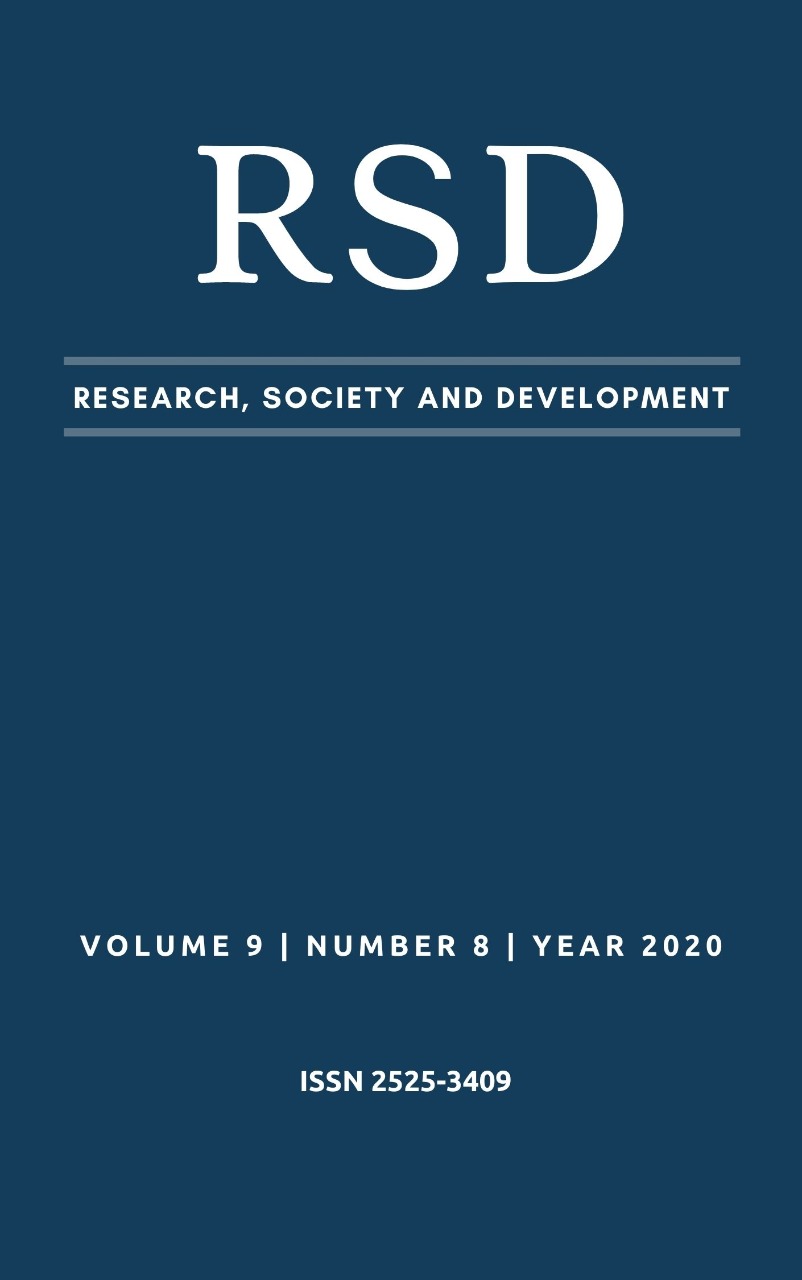Currículo e Educação Física: algumas relações com/sobre o corpo
DOI:
https://doi.org/10.33448/rsd-v9i8.5826Palavras-chave:
Corpo humano, Currículo, Educação física.Resumo
O objetivo deste trabalho é discutir a relação entre corpo, currículo e Educação Física, por meio de uma reflexão teórica. Para tanto, foram utilizadas diferentes fontes bibliográficas para pensar as relações entre essas três categorias. Vale salientar que o estabelecimento dessas relações só foi possível pela abrangência e complexidade com que a concepção de currículo – e de corpo - é aqui assumida. Para tanto, o artigo está organizado em quatro sessões: 1) Traçados iniciais; 2) Corpo e Educação Física: reflexões a partir do currículo; 3) A Educação Física como forma de produzir corpos; e, 4) Considerações finais. As reflexões apresentadas no âmbito das relações entre corpo, currículo e Educação Física demonstraram como esses três aspectos estão imbricados, se constroem e são reconstruídos constantemente, dependendo do contexto sociocultural em que se vive. Educação Física, um campo de saber, uma prática pedagógica permeada pelo corpo, como objeto de estudo e conhecimento, tem na escola e em espaços-tempos educacionais o currículo como meio de produção de discursos e subjetividades. Conclui-se que refletir acerca das práticas curriculares e pedagógicas, em especial na/da Educação Física, permite-nos pensar sobre a compreensão de corpo [e de sujeito] na sociedade moderna e contemporânea.
Referências
Barbosa, C. L. de. A. (2010). Educação Física e Didática: um diálogo possível e necessário. Petrópolis: Vozes.
Bracht, V. (2005). Sociologia crítica do esporte: uma introdução. 3. ed. Ijuí: Unijuí.
Brasil. (1997). Parâmetros Curriculares Nacionais. Introdução aos Parâmetros Curriculares Educacionais, Brasília.
Castellani Filho, L. (2003). Educação física no Brasil: a história que não se conta. 8. ed. Campinas: Papirus.
Costa, J. F. (1999). Ordem médica e norma familiar. 4. ed. Rio de Janeiro: Graal.
Daólio, J. (1998). Educação física brasileira: autores e atores da década de 1980. Campinas, SP: Papirus.
Demo, P. (2005). Metodologia da investigação em Educação. Curitiba: Ibpex.
Elias, N. (1994). A Sociedade dos Indivíduos. Rio de Janeiro: Zahar.
Courtine, J. (2013). Decifrar o corpo: pensar com Foucault. Tradução Francisco Morás. Petrópolis, RJ: Vozes.
Deleuze, G. (2005). Foucault. 5. ed. Tradução de Cláudia Sant`Anna Martins. São Paulo: Brasiliense.
Foucault, M. (1992). Microfísica do poder. Rio de Janeiro: Graal.
Foucault, M. (1995). O sujeito e o poder. In: DREYFUS, H.; RABINOW, P. Michel Foucault. Uma trajetória Filosófica: Para Além do Estruturalismo e da Hermenêutica. Rio de Janeiro: Forense Universitária, p.231-249.
Foucault, M. (2011). Vigiar e punir: nascimento da prisão. 39. ed. Petrópolis: Vozes.
Gonçalves, A. S. & Azevedo, A. A. (2007). A Re-Significação Do Corpo Pela Educação Física Escolar, Face Ao Estereótipo Construído Na Contemporaneidade. Pensar a Prática, 10/2, p. 201-219.
Ilha, F.R.S. (2019). As condições de emergência histórica na construção dos currículos da Educação Física: os discursos curriculares em questão. Rev. Eletrônica Pesquiseduca. Santos, Volume 11, número 25, p.344-357, set-dez.
Lopes, B. R. & Lara, L. M. (2018). Cultura como central ou periférica na produção de conhecimento em educação física no Brasil sob a ótica de pesquisadores. Revista Brasileira de Ciências do Esporte. vol.40 no.2 Porto Alegre Apr/June. Acesso em 30 abril de 2020, em https://www.scielo.br/scielo.php?script=sci_arttext&pid=S0101-32892018000200146
Mauss, M. (1974). Sociologia e Antropologia. São Paulo, EPU.
Mendes, C.L. (2006). O corpo em Foucault: superfície de disciplinamento e governo. Revista de Ciências Humanas, Florianópolis, EDUFSC, n. 39, p. 167-181.
MENEGUETTI, F.K. (2011). O que é um Ensaio-Teórico? RAC, Curitiba, v. 15, n. 2, pp. 320-332, Mar./Abr.
Neira, M. G & Nunes, M. L. (2009). Educação Física, currículo e cultura. São Paulo: Phorte.
Popkewitz, T.S. (1994). História do Currículo, Regulação Social e Poder. In: SILVA, T.T. (Org.). O sujeito da educação: estudos foucaultianos. Petrópolis: Vozes, p.173-210.
Popkewitz, T.S. (2004). The alchemy of the mathematics curriculum: inscription and fabrication of the child. American Educational Research Journal, v.41, p.3-34.
Sant’anna, D. (2005). Políticas do corpo: elementos para uma história das práticas corporais. São Paulo: Estação Liberdade.
Santin, S. (2008). Corporeidade. In: GONZÁLEZ, F.J.; FENSTERSEIFER, P.E. Dicionário Crítico de Educação Física. 2. ed. rev. Ijuí: Ed. UNIJUÍ.
Schwengber, M.S.V. (2008). Corpo-sujeito. In: GONZÁLEZ, F.J.; FENSTERSEIFER, P.E. Dicionário Crítico de Educação Física. 2. ed. rev. Ijuí: Ed. UNIJUÍ.
Silva, T.T. (2011). Documentos de identidade: uma introdução às teorias do currículo. 3. ed. Belo Horizonte: Autêntica.
Soares, C. L. (1994). Educação física: raízes européias e Brasil. Campinas: Autores Associados.
Soares, C. L. (2006). Pedagogias do corpo: higiene, ginástica e esporte. In: RAGO, M.; VEIGA-NETO, A. Figuras de Foucault. Belo Horizonte: Autêntica, p. 75-86.
Soares, C. et al. (1992). Metodologia do Ensino da Educação Física.
Veiga-Neto, A. (2014). Educação Física: Pensando as controvérsias. Mesa redonda. In: EXTREMUS DP SUL (Educação Física: digressões, controvérsias e perspectivas), 6., 2014, RS. Anais... Rio Grande: Universidade Federal de Rio Grande (FURG).
Vieira, J. S. (2009). Currículo Rastros, Histórias, Blasfêmias, Dissoluções, Deslizamentos, Pistas. Debates em Educação. Maceió, v. 1, n. 2 jul./dez.
Vigarello, G. (2003). A história e os modelos do corpo. PróPosições, v. 14, n. 2, p. 21-29, mai./ago.
Downloads
Publicado
Edição
Seção
Licença
Copyright (c) 2020 Franciele Roos da Silva Ilha, Andrize Ramires Costa, Eliane Regina Crestani Tortola

Este trabalho está licenciado sob uma licença Creative Commons Attribution 4.0 International License.
Autores que publicam nesta revista concordam com os seguintes termos:
1) Autores mantém os direitos autorais e concedem à revista o direito de primeira publicação, com o trabalho simultaneamente licenciado sob a Licença Creative Commons Attribution que permite o compartilhamento do trabalho com reconhecimento da autoria e publicação inicial nesta revista.
2) Autores têm autorização para assumir contratos adicionais separadamente, para distribuição não-exclusiva da versão do trabalho publicada nesta revista (ex.: publicar em repositório institucional ou como capítulo de livro), com reconhecimento de autoria e publicação inicial nesta revista.
3) Autores têm permissão e são estimulados a publicar e distribuir seu trabalho online (ex.: em repositórios institucionais ou na sua página pessoal) a qualquer ponto antes ou durante o processo editorial, já que isso pode gerar alterações produtivas, bem como aumentar o impacto e a citação do trabalho publicado.


